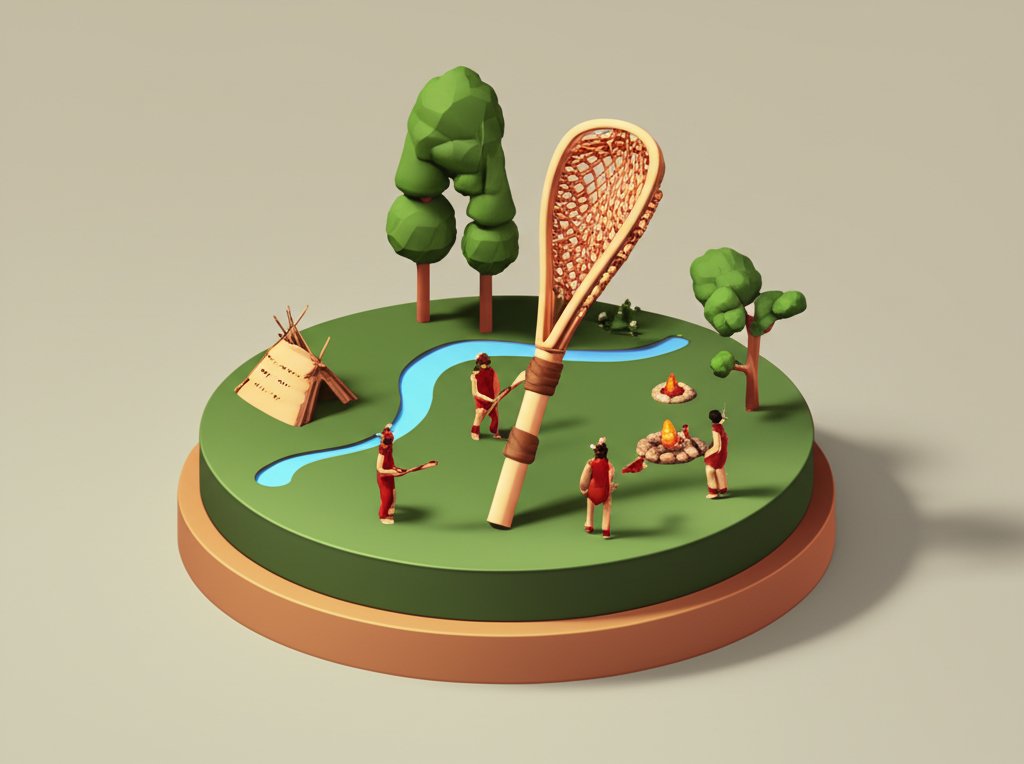Embark on an epic journey through time as we peel back the layers of lacrosse history, a sport rich with ancient traditions, strategic cunning, and remarkable evolution. Far from just a game, lacrosse is a living tapestry woven with intriguing lacrosse tales and profound cultural significance. In this article, we’ll dig deep into the enigmatic lacrosse past, uncovering forgotten narratives and pivotal moments that have shaped this beloved game. Prepare to be captivated by the untold stories that will illuminate the true depth and enduring spirit of a sport that began as a sacred ritual and transformed into a global phenomenon.
The Sacred Origins: History of Lacrosse as “The Creator’s Game”

To truly grasp the essence of lacrosse history, we must first travel across millennia to its profound origins among the Indigenous peoples of North America. For countless generations, long before European contact, this game was not merely a pastime but a spiritual endeavor, a ceremonial rite, and a vital part of community life. Known by various names such as Tewaaraton (Mohawk for “little brother of war”), Baggataway (Ojibwe), or Dehoñtjihgwa’es (Onondaga), it was revered as “The Creator’s Game” or “medicine game.”
Deep Roots in Indigenous Cultures
Across the vast landscapes of North America, from the Great Lakes region to the Southeastern woodlands, diverse Indigenous nations developed their unique versions of the game. The sticks, crafted from hickory or other strong woods, featured netted heads of varying sizes, designed to scoop, carry, and throw a deer hide ball. Matches were colossal events, sometimes involving hundreds or even thousands of players from multiple villages or tribes, stretching over vast fields that could span miles. These weren’t quick contests; games could last for days, from sunrise to sunset, with breaks for feasting and ceremony.
The purpose of these games transcended simple competition. They were played for sacred reasons: to resolve disputes peacefully between tribes, to heal the sick, to prepare warriors for battle, and to honor the Creator. The physical demands of the game were immense, fostering strength, agility, and endurance, while its spiritual aspect instilled discipline, respect, and communal harmony. Players often underwent rigorous purification rituals, fasting, and spiritual preparation, believing the game was a direct offering to the Creator, a way to maintain balance and health within their communities.
Beyond its spiritual significance, lacrosse held a prominent place in conflict resolution and community building, a history further explored in these amazing lacrosse facts.
“Little Brother of War”: Lacrosse Past as a Strategic Tool

One of the most compelling aspects of lacrosse past is its deep connection to warfare. While primarily a game, its intensity and physical nature earned it the moniker “little brother of war.” The skills honed on the lacrosse field – speed, agility, stick-handling, and strategic thinking – were directly transferable to the battlefield. More than just training, lacrosse was occasionally employed as a cunning tactical maneuver during actual conflicts.
Lacrosse in Military Stratagem
Perhaps the most famous historical anecdote lacrosse offers about its wartime use comes from the Pontiac’s War in 1763. During the siege of Fort Michilimackinac, a British outpost, Ojibwe warriors staged a seemingly innocent lacrosse game outside the fort’s gates. British soldiers, intrigued by the spectacle, gathered to watch. At a pre-arranged signal, the ball was intentionally thrown close to the fort’s gate. As the players rushed to retrieve it, they seized the weapons that had been hidden nearby, launching a surprise attack that quickly overwhelmed the unsuspecting British garrison. This brilliant ruse demonstrates the profound tactical depth and cultural significance that lacrosse held, blurring the lines between sport and survival.
Beyond direct military deception, the game served as a proxy for war, allowing tribes to vent aggression, resolve grievances, and demonstrate strength without resorting to full-scale conflict. It was a complex system of social control and inter-tribal diplomacy, where the stakes were often high, including land, resources, or even honor.
The Great Transition: From Ritual to Modern Sport
The arrival of European settlers marked a pivotal turning point in lacrosse history. Jesuits, particularly Jean de Brébeuf in the 17th century, were among the first Europeans to witness the game. Brébeuf, struck by the stick’s resemblance to a bishop’s crosier, named the game “la crosse” (French for “the stick”), a name that eventually stuck. For centuries, the game remained largely within Indigenous communities, but by the mid-19th century, it began its transformation into the organized sport we recognize today.
The Architect of Modern Lacrosse: William George Beers
The true father of modern lacrosse is widely considered to be William George Beers, a Canadian dentist and avid lacrosse enthusiast. Recognizing the game’s potential beyond its Indigenous roots, Beers meticulously codified the first set of written rules in 1856 and later, in 1867, standardized them into what became known as the “Montreal Rules.” These rules reduced the number of players, shortened the playing field, and introduced modern equipment standards.
Beers was a visionary. He founded the Montreal Lacrosse Club, organized matches, and tirelessly promoted the sport, taking Canadian teams on exhibition tours to England, Scotland, and Ireland in the 1860s and 1870s. These tours were instrumental in introducing lacrosse to a global audience, showcasing its athleticism and excitement. His efforts laid the groundwork for lacrosse to evolve from a tribal ritual into an internationally recognized amateur sport.
Pioneers and Intriguing Lacrosse Tales: Breaking Barriers and Building Legacies
The journey of lacrosse from ancient fields to modern stadiums is filled with individuals and communities who broke barriers, defied expectations, and forged lasting legacies. These intriguing lacrosse tales highlight the sport’s adaptive nature and its capacity to inspire change.
The Dawn of Women’s Lacrosse
While the early popularized version of lacrosse was predominantly male, women soon sought their place on the field. The history of lacrosse saw a significant milestone in 1890 when the first documented women’s lacrosse game was played at the St. Leonards School in Scotland. Pioneering educators, recognizing the physical and character-building benefits of the sport, adapted the rules to suit women’s play, focusing more on skill and strategy rather than direct physical contact.
The sport slowly gained traction, and by 1926, the first women’s lacrosse team was formed in the United States, at the Bryn Mawr School in Baltimore. This marked the beginning of organized women’s lacrosse in America, paving the way for leagues, tournaments, and eventually, international competition. The evolution of women’s lacrosse illustrates a powerful story of empowerment and the breaking of gender barriers in sport, proving that the inherent appeal of “The Creator’s Game” transcended traditional boundaries.
The Olympic Stage and Beyond
Lacrosse briefly graced the Olympic stage, appearing as a medal sport in the 1904 St. Louis Games and the 1908 London Games. While it didn’t maintain its status as a permanent Olympic sport, its inclusion was a testament to its growing international recognition in the early 20th century. Post-Olympics, lacrosse continued to flourish, particularly in North America and Great Britain, with clubs and collegiate programs taking root and expanding its reach.
The establishment of collegiate leagues, particularly in the United States East Coast, solidified lacrosse’s place in the athletic landscape. The intercollegiate rivalries and championships fueled its popularity, creating a pipeline of talent and a passionate fan base that continues to grow today.
Global Expansion and Enduring Legacy: The Modern Lacrosse History
From its spiritual origins, through periods of adaptation and formalization, lacrosse history continues to be written. Today, lacrosse is a truly global sport, played in dozens of countries across six continents, with international federations working tirelessly to promote its growth and ensure its eventual return to the Olympic Games.
Box Lacrosse: A Canadian Innovation
A significant evolution in lacrosse past and present is the emergence of box lacrosse. Born in Canada during the 1930s, box lacrosse adapted the field game to indoor hockey rinks. Characterized by smaller goals, heavier padding, and more physical play within the confines of arena boards, box lacrosse became immensely popular, particularly among Indigenous communities and in Canada. It fostered a unique style of play, emphasizing quick reflexes, tight stick skills, and aggressive defensive strategies. Many field lacrosse stars, especially from Canada, credit their box lacrosse background for their exceptional stick work and vision.
Indigenous Roots Reaffirmed
In recent decades, there has been a powerful resurgence and reclamation of lacrosse’s Indigenous roots. Nations like the Haudenosaunee (Iroquois Confederacy) have formed their national teams, competing on the international stage, not merely as a country but as a sovereign Indigenous nation. This participation is a profound affirmation of their cultural heritage and the spiritual significance the game continues to hold for them. Their presence in global tournaments serves as a powerful reminder of where lacrosse history truly began, bringing the story full circle.
The sport’s journey is one of resilience, adaptation, and an unwavering spirit. From ancient ritual to global competition, the ball continues to fly, propelled by sticks that echo the craftsmanship of centuries past, carrying with it the whispers of intriguing lacrosse tales and the promise of an even more dynamic future.
Conclusion
The history of lacrosse is a captivating saga, stretching from the sacred ceremonial fields of Indigenous North America to the vibrant international arenas of today. We’ve explored its profound spiritual origins, its strategic role in warfare, the pivotal modernization efforts of figures like William George Beers, and the inspiring emergence of women’s lacrosse. Each chapter of lacrosse past is filled with historical anecdotes lacrosse enthusiasts cherish, revealing a sport that is much more than sticks and a ball; it’s a living cultural artifact, a testament to human ingenuity, athleticism, and enduring community spirit.
As we conclude our journey through these intriguing lacrosse tales, it’s clear that the game’s rich heritage continues to shape its present and future. Whether you’re a seasoned player, a new fan, or a history enthusiast, understanding the roots of this dynamic sport deepens appreciation for its complexities and honors the traditions from which it sprang. So next time you see a game, remember the centuries of history contained within each pass, each shot, each exhilarating moment – a legacy still unfolding.
FAQ: Uncovering More About Lacrosse’s Rich Past
Q1: What is the earliest known origin of lacrosse?
A1: The earliest known origins of lacrosse date back centuries, with Indigenous peoples of North America playing the game long before European contact. Archaeological evidence and oral traditions suggest versions of the game existed as early as the 12th century, particularly among the Eastern Woodlands tribes. It was known by various names, such as Tewaaraton (Mohawk) or Baggataway (Ojibwe), and was deeply embedded in spiritual, social, and political life.
Q2: How did lacrosse get its name?
A2: The name “lacrosse” was coined by Jean de Brébeuf, a French Jesuit missionary, in the 17th century. He was among the first Europeans to observe the game being played by Huron Indigenous people. Brébeuf noted that the players’ sticks resembled a bishop’s crosier, which is called “la crosse” in French. The name “la crosse” eventually evolved into the English “lacrosse.”
Q3: Was lacrosse truly used as a weapon in war?
A3: Yes, lacrosse had a dual nature as both a game and a tool related to warfare. While not a weapon in the traditional sense, its intense physical training prepared warriors, and it was strategically employed as a military ruse. The most famous example is the Ojibwe attack on Fort Michilimackinac in 1763, where a staged lacrosse game led directly to a successful surprise assault on the British garrison.
Q4: Who developed the modern rules of lacrosse?
A4: William George Beers, a Canadian dentist, is widely credited with standardizing the modern rules of lacrosse. In the mid-19th century, he codified the “Montreal Rules” in 1867, which reduced the number of players, specified field dimensions, and standardized equipment, transforming the traditional Indigenous game into an organized sport.
Q5: When did women’s lacrosse first begin?
A5: The first recorded women’s lacrosse game took place in 1890 at the St. Leonards School in Scotland. The sport was then introduced to the United States, with the first American women’s team forming in 1926 at the Bryn Mawr School in Baltimore. Women’s lacrosse developed with modified rules to emphasize skill and strategy over physicality, catering to the norms of the era.
Q6: What is “box lacrosse” and where did it originate?
A6: Box lacrosse is a version of lacrosse played indoors, typically in converted hockey rinks. It originated in Canada during the 1930s, born out of a desire for an indoor version of the sport. Characterized by smaller goals, heavier padding, and continuous play within the boards, box lacrosse emphasizes quickness, precise stick skills, and physical defense, and is extremely popular in Canada.
Q7: Why is lacrosse often referred to as “The Creator’s Game”?
A7: “The Creator’s Game” is a term often used by Indigenous peoples to describe lacrosse due to its profound spiritual significance. For many Native American tribes, the game was considered a gift from the Creator, played not just for entertainment but to honor the Creator, resolve disputes peacefully, heal the sick, and prepare individuals for life’s challenges. It was a sacred ceremony, fostering community and spiritual well-being.
Q8: Has lacrosse ever been an Olympic sport?
A8: Yes, lacrosse was officially featured as a medal sport in the Summer Olympics twice: in St. Louis in 1904 and London in 1908. It also appeared as a demonstration sport in the 1928, 1932, and 1948 Olympics. There’s a strong ongoing effort by international lacrosse federations to have it reinstated as a permanent Olympic sport.
Q9: How has the lacrosse stick evolved over time?
A9: The lacrosse stick has undergone significant evolution. Early Indigenous sticks were hand-carved from single pieces of wood, often hickory, with rawhide netting. Over time, designs became more specialized for different positions. The modern era saw the introduction of manufactured plastic heads in the 1970s, making sticks lighter, more durable, and consistent. Today’s sticks feature synthetic pockets, lightweight shafts, and specialized designs for offensive, defensive, and goaltending positions.
Q10: What is the significance of the Haudenosaunee in modern lacrosse?
A10: The Haudenosaunee (Iroquois Confederacy) are profoundly significant to modern lacrosse history as the originators and principal custodians of “The Creator’s Game.” Today, they compete internationally as the Haudenosaunee Nationals, a sovereign team that represents their Confederacy, not just a country. Their participation at the highest levels of international competition serves as a powerful assertion of their identity, culture, and enduring connection to the sport’s ancient roots, bringing Indigenous heritage directly into the global spotlight.










